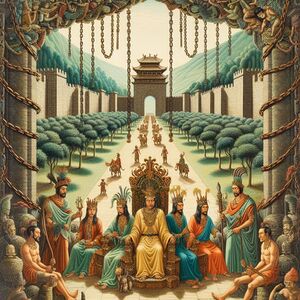Captivity of Weeping Sores

The Captivity of Weeping Sores as the Chimor people call it, also known as the Golden Refuge in official Daxian sources refers to the captivity of the entire Chimoche royal family from 1714 to 2015 by Daxia. After Chimoche's defeat in the Second Qian-Chimor war, king Tizroc V was captured alongside with all of his family and escorted into captivity at the Pinghai fortress. Tizroc V and his family would spend the next fifteen years there in cramped accommodation. Upon Tizroc's death in 1729, his successor Tizroc VI and the rest of the royal clan would be moved to mainland Daxia. They were then escorted overland to the Blue Tile Palace (Daxian:Lanse Cízhuān) in northern Daxia which would be the clan's permanent abode for the next 287 years. The captivity of the king and his family enhanced Daxia's position vis a vis truculent Ixa'Taka, the king could be reinstated on his throne and his claims to Ixa'Takan territory pursued on his behalf if Ixa'Taka displeased the Qian. The king's spiritual importance to his people also helped keep the Chimor pliant and subdued for at least two generations. The captivity of the royal bloodline of Chimoche was ended in 2015 with the implementation of the new Law on Autonomies that established the Chimor Autonomy and King Falcao IX was placed again on the throne of Shagur, albeit with much diminished powers.
The Qian and their successor governments treated the Chimor royal clan with relative gentleness. No member of the family was allowed outside the palace grounds but as members of royalty they were allowed free use of most of the compound. To help the kings distract themselves they were routinely handed fictitious reports from Xisheng's Governor General. They were also allowed to maintain a court of sorts, formed mostly of their own relatives. The education of the new heir was undertaken by Daxian officials and the coronation of new kings was also supervised by them. Concubines from Chimoche were shipped in to continue the royal line but over time Daxian women were also introduced, such that in later generations some members of the family had lost many of their Chimor physical characteristics. There was also much inbreeding as concubines were usually reserved for the king and his offspring; uncles, cousins and the like were forced to make do with their female relatives. This would sometimes result in monstrosities and disabled children being born.